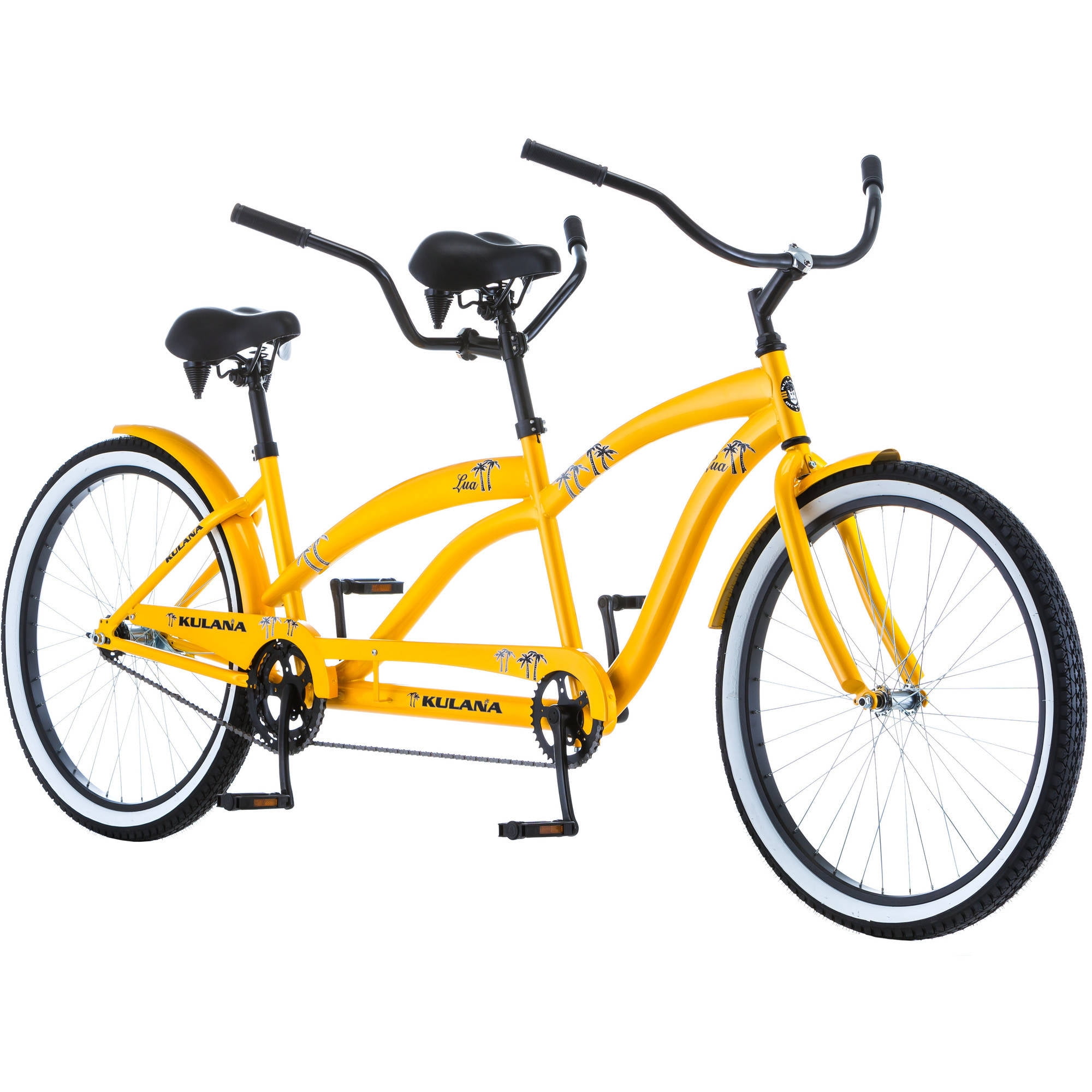In comparing a tandem bike and a single bike, a tandem bike is designed for two riders, while a single bike is meant for one rider. Tandem bikes offer a shared riding experience, ideal for couples or friends, while single bikes are for individual use.
Tandem bikes create a fun and collaborative experience, allowing riders to cycle together and share the workload. On the other hand, single bikes offer independence and control over the riding pace and direction. Both options have their unique advantages and suit different riding preferences.
Understanding the differences and benefits can help you choose the most suitable bike for your cycling needs and preferences. Whether you prefer tandem riding for companionship or individual biking for autonomy, both options provide an enjoyable cycling experience.
Credit: www.quora.com
History Of Tandem Bikes
Tandem bikes have a rich history, dating back to the late 19th century. While single bikes offer independent control, tandem bikes provide a unique experience with synchronized pedaling and teamwork. Consider the pros and cons when deciding which type suits your riding style and preferences.
Design And Structure
Tandem bikes and single bikes differ in various aspects, including design and structure. These elements play a significant role in determining the comfort, handling, and overall performance of the bike. In this section, we will delve into the design and structure of tandem bikes and single bikes, exploring the features that make each option unique.
Frame
The frame is the backbone of any bike, dictating its overall strength, stability, and weight. When it comes to tandem bikes, the frame design is paramount to accommodate two riders. Tandem bike frames are specifically engineered to withstand the additional weight and forces exerted by two riders working in unison. These frames often incorporate a longer wheelbase and additional reinforcement to ensure optimum stability and durability.
On the other hand, single bike frames are designed for a single rider and are typically lighter and more nimble. They are constructed to prioritize factors like speed, maneuverability, and solo rider comfort. Single bike frames may vary in terms of materials, such as aluminum, carbon fiber, or steel, with each offering its unique benefits in terms of weight, rigidity, and responsiveness.
Handlebars
Handlebars are vital for steering and control, and they also contribute to the overall riding experience. In tandem bikes, there are typically two sets of handlebars to accommodate both riders. These handlebars are positioned side by side or one behind the other, allowing both riders to have a firm grip and contribute to the bike’s steering. The design and placement of handlebars in tandem bikes promote effective communication and coordination between riders.
Single bikes, on the other hand, generally have a single set of handlebars positioned in front of the rider. They come in various shapes and styles, including drop bars, flat bars, and riser bars, each catering to different riding preferences and purposes. The choice of handlebars in single bikes depends on factors like riding style, terrain, and personal comfort.
Seating Arrangement
In tandem bikes, the seating arrangement is a key factor in ensuring comfort and balance for both riders. Tandem bikes usually have two seating positions, with one rider sitting in front and the other in the back. This arrangement allows for better weight distribution and coordination, enabling both riders to pedal in sync. Additionally, tandem bikes often provide adjustable seating options, allowing riders of different heights to find their optimal position.
Single bikes, in contrast, follow a straightforward seating arrangement with a single rider positioned in the center of the frame. The seating position can be adjustable to cater to individual preferences, allowing riders to find the most comfortable and efficient pedaling position.
Advantages Of Tandem Bikes
Tandem bikes offer unique advantages over single bikes. Riding a tandem bike allows for better communication, teamwork, and bonding between riders. Additionally, tandem bikes provide a smoother, more stable ride, making them a great choice for leisurely cycling adventures.
Improved Teamwork And Communication
Using a tandem bike encourages teamwork and communication between riders. It requires synchronization to pedal in harmony.
Enhanced Speed And Efficiency
Tandem bikes offer increased speed and efficiency due to dual pedal power. They can outpace single bikes.
Opportunity For Shared Experience
Riding a tandem bike ensures a shared experience, fostering connection and camaraderie among riders.

Credit: www.earthridercycling.com
Disadvantages Of Tandem Bikes
Tandem bikes offer numerous benefits for riding partners, but they also have their drawbacks. Understanding the disadvantages of tandem bikes can help you make an informed decision when choosing the right bike for your needs. From the need for synchronization between riders to the challenges of maneuvering such a large and heavy bike, there are several factors to consider before investing in a tandem bike.
Requires Synchronization
One of the main disadvantages of tandem bikes is the need for perfect synchronization between the riders. Both riders must pedal at the same cadence and exert the same amount of effort to maintain balance and ensure a smooth ride. This can be challenging, especially for riders with different fitness levels or riding styles. Mismatched pedaling can lead to inefficiency and cause discomfort, making the ride less enjoyable.
Difficult Maneuverability
Maneuvering a tandem bike can be quite challenging due to its length and weight. Navigating through tight spaces, sharp turns, or crowded areas can be more complicated compared to single bikes. Additionally, starting and stopping the bike may require extra coordination between the riders, which can be particularly daunting for beginners.
Weight And Size
Another disadvantage of tandem bikes is their significant weight and size. Transporting and storing a tandem bike can be more cumbersome compared to a single bike. The larger frame and double components also mean that tandem bikes are generally heavier, which can make them more challenging to handle, especially on rough terrain or inclines.
Single Bikes: Benefits And Features
Exploring the benefits and features of single bikes versus tandem bikes can help riders make an informed choice. Single bikes offer greater maneuverability and customized control for riders seeking individual experiences, while tandem bikes provide unique opportunities for shared adventures and teamwork on the road.
Ultimately, both types of bikes have their own advantages, catering to different preferences and riding styles.
Independence And Control
When it comes to single bikes, one of the key benefits is the independence and control they offer. Riders have the opportunity to set their own pace and direction, allowing for a more personalized and individualized riding experience. This level of autonomy is particularly appealing to those who prefer to have complete control over their cycling journey.
Ease Of Maneuvering
Single bikes are known for their ease of maneuvering, making them ideal for navigating through crowded streets or tight spaces. This agility and responsiveness allow riders to easily navigate around obstacles and make quick adjustments to their speed and direction, enhancing the overall riding experience. This feature makes single bikes a popular choice for urban commuting and recreational cycling alike.
Variety Of Styles And Options
Single bikes come in a wide variety of styles and options, catering to the diverse preferences of cyclists. Whether it’s a sleek and minimalist design for city riding or a rugged and durable frame for off-road adventures, there is a single bike to suit every rider’s needs. Additionally, the customization potential of single bikes allows cyclists to personalize their rides with unique components and accessories, adding both style and functionality to their cycling experience.
Choosing Between Tandem And Single Bikes
When it comes to deciding between a tandem bike and a single bike, there are a few key considerations to keep in mind. Whether you prefer to ride solo, with a partner, or in a group or family setting, each option has its benefits and drawbacks. To help you make an informed decision, let’s explore these considerations below.
Considerations For Riding Solo
If you enjoy the freedom and solitude of riding solo, then a single bike may be the ideal choice for you. Here are some important factors to consider when deciding:
- Comfort: Single bikes typically offer more customizable options when it comes to finding a comfortable riding position. You can easily adjust the seat height, handlebar position, and other components to fit your specific needs.
- Maneuverability: Single bikes are lighter and easier to navigate compared to tandems. This can be particularly advantageous when riding on challenging terrains or navigating tight turns.
- Speed: Since you are the sole rider, you have complete control over your speed and can push yourself to achieve your desired pace.
Ultimately, riding solo on a single bike allows you to immerse yourself in the cycling experience, enjoying the thrill and freedom that comes with it.
Couples Or Partners
For couples or partners looking to enjoy biking together, a tandem bike offers several advantages. Here are some factors to consider:
- Shared Experience: Riding a tandem bike allows you to share the cycling experience with your partner, building a strong bond and creating lasting memories together.
- Improved Communication: Riding in sync on a tandem bike requires good communication and teamwork. It enhances your ability to coordinate and navigate as a team.
- Equal Effort: Tandem bikes distribute the workload evenly between riders, making it an excellent choice for couples with varying fitness levels. You can enjoy the ride together, regardless of individual strengths or abilities.
By opting for a tandem bike, couples can enjoy the benefits of companionship and collaboration while exploring the wonders of the great outdoors.
Group Or Family Rides
If you often participate in group or family rides, both single and tandem bikes have their merits. Here’s what to consider:
| Single Bikes | Tandem Bikes |
|---|---|
| Each rider can maintain their own pace and choose their preferred route. | Easy coordination and communication within the group, allowing everyone to ride together smoothly. |
| More flexibility in terms of bike sizes and configurations to accommodate riders of different ages and heights. | Equalized effort, making it suitable for riders with varying fitness levels. |
| Freedom to explore individually. | Shared experience and enhanced social interaction during the ride. |
Ultimately, whether you choose a single or tandem bike for group or family rides depends on factors such as personal preferences, riding dynamics, and the overall goals for the ride.

Credit: www.walmart.com
Frequently Asked Questions For Tandem Bike Vs Single
What Are The Disadvantages Of Tandem Bikes?
Tandem bikes have a few disadvantages. Firstly, they can be difficult to maneuver, especially in tight spaces. Secondly, they require good communication and coordination between riders. Lastly, hills and inclines can be more challenging to navigate due to the additional weight and length of the tandem bike.
Is It Hard To Ride A Tandem Bike Alone?
Riding a tandem bike alone can be challenging due to its length and weight distribution. The bike’s stability is optimized when two people ride, so riding alone may require more effort and control. It’s recommended to have a partner to fully enjoy the tandem bike experience.
Is A Tandem Bike Faster Than A Single?
Yes, a tandem bike can be faster than a single bike due to the combined power of two riders working together.
What’s The Point Of A Tandem Bike?
A tandem bike allows two riders to pedal together, promoting teamwork and communication. It’s great for bonding, providing a shared experience, and increasing social interaction. Tandem biking also offers inclusivity for individuals with disabilities, ensuring everyone can enjoy cycling together.
Conclusion
In weighing the options between tandem and single bikes, it’s crucial to consider personal preferences and biking goals. Both choices offer distinct advantages, from team bonding on tandems to independent rides on singles. Ultimately, the decision rests on individual needs and the biking experience desired.
Choose wisely!



